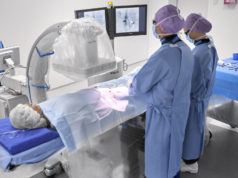
The application of new technologies and techniques to treat challenging and high-risk thoracic aortic pathologies were highlighted by aortic specialists on day one of the third annual CX Aortic Vienna meeting (24–26 October, Digital).
Experience in endovascular arch repair in the presence of a mechanical aortic valve and thrombus removal in the ascending thoracic aorta were two of the cutting-edge approaches in the spotlight, and discussion on aortic dissection—which was punctuated by polling on the importance of the location of the primary entry tear and the presence or absence of malperfusion—also attracted interest from the CX Aortic Vienna audience, tuning in from across the globe.
Opening the session, Michael Jacobs (Maastricht, The Netherlands) walked attendees through an edited case highlighting open thoracoabdominal aortic aneurysm (TAAA) repair in a young Marfan patient, in which he focused in particular on visceral, renal and segmental artery reconstruction techniques. The presentation detailed some of the pre- and periprocedural steps employed in these cases.
This was followed by the presentation of Martin Czerny (Freiburg, Germany), who argued the importance of the location of the primary entry tear and the extent of the disease in acute aortic dissection, where he documented new approaches to classification of aortic dissection and discussed treatment strategies. The extent of retrograde propagation often makes a difference, Czerny argued, adding that distal malperfusion is frequently associated with primary entry tear within the aortic arch and proximal descending aorta.
Polling taken after Czerny’s presentation revealed that as many as 96% of attendees to the session may have agreed with the thrust of his argument—that location of the primary entry tear and the presence or absence of malperfusion can be considered the ‘be all and end all’—but the session’s discussants Alexander Zimmerman (Zurich, Switzerland), Markus Steinbauer (Regensburg, Germany) and Roberto Chiesa (Milan, Italy) agreed that questions remain as to the validity of the statement.
Nikoloas Tsilimparis (Munich, Germany) continued the session by detailing complex cases involving endovascular arch repair in Ishimaru zone 0 in the presence of a mechanical aortic valve, demonstrating the technical feasibility of treating these patients —who have previously been contraindicated for endovascular repair—using a technique that involves crossing the aortic valve with an arch branch endograft. The presentation drew interest from the panel, who acknowledged the inherent challenge in treating these patients, with the session’s anchor, Roger Greenhalgh (London, United Kingdom), commenting that the procedure stands at the “edge of endovascular intervention”.
Continuing the theme of applying innovation to tackle challenging cases, Sabine Wipper (Innsbruck, Austria) detailed cases involving the removal of a floating thrombus in the descending thoracic aorta, employing a specific vacuum-assisted venous thrombectomy device.












